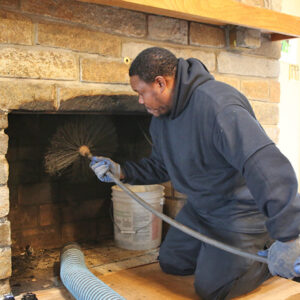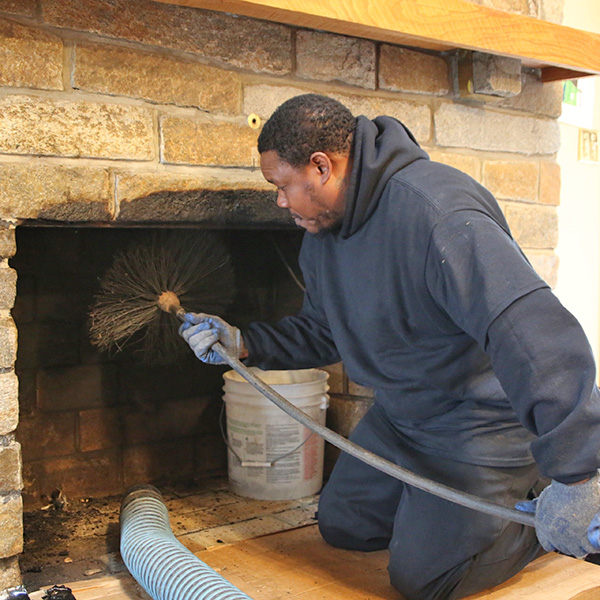A chimney collapse can be disastrous, destroying parts of your home and injuring people below. An ounce of prevention is worth a pound of cure, which is why it’s important to get your chimney inspected on a yearly basis. For professional assistance, contact Chimney Inspection Charleston SC.
A level two inspection is required when a change in fuel type, flue shape, or material, or a chimney liner replacement, has been made. Also, a level two is necessary upon the sale or transfer of your property and after an operational malfunction or external event.
As wood or fossil fuel burns, it releases inflammable smoke that rises through the chimney. As the smoke travels through the chimney, it cools and condenses into a tarry residue known as creosote. This substance is very flammable, and if it is allowed to build up inside the chimney, it can ignite into a dangerous chimney fire.
Homeowners can minimize the accumulation of creosote by following several preventative measures. For example, they should always use seasoned wood that has been properly dried before burning it in their fireplaces. This drier, more combustible wood will generate less creosote during combustion and allow the smoke to flow more quickly out of the fireplace. Additionally, homeowners should make sure their chimneys are well insulated to warm the air entering the flue so that it burns more efficiently and produces less creosote.
If a homeowner notices that their fireplace has a black, oily residue or that it is not producing as much heat as it used to, they may have an issue with creosote buildup. It’s important to schedule a chimney inspection with a certified chimney sweep as soon as possible to find out the cause of this problem and take appropriate action.
A Level 1 chimney inspection is recommended by the National Fire Protection Association (NFPA) and includes a visual examination of the interior and exterior of the chimney. It also includes checking the proper clearances from combustibles in accessible areas such as attics, crawl spaces, and basements.
During a Level 2 chimney inspection, the certified chimney sweep will look for more extensive damage to the masonry or steel structure of the chimney. They will also examine the flue lining for problems such as cracking or discoloration that could indicate the need for replacement. They will also determine whether the chimney is leaking into the house through the lining, and if so, they will recommend any necessary repairs.
Chimney sweeps will also identify and remove any visible creosote accumulation in the flue or lining. When creosote reaches stage 3, it becomes a sticky, tar-like material that is highly flammable. At this point, it resembles concentrated fuel and requires professional removal with chemical cleansers.
Damaged chimney caps
When a chimney cap is damaged, it should be replaced immediately. This is because a damaged cap could allow debris to fall into the chimney and cause damage. It could also allow smoke and carbon monoxide to enter the home.
Chimney caps have several important functions, including keeping debris, birds, and varmints out of the fireplace and flue. Without a chimney cap, twigs, leaves, branches, and animal droppings can easily make their way to the flue and block the venting of fire and gases from the chimney. In addition, if an animal nests in the chimney, it can block the air flow and lead to carbon monoxide poisoning in the home. Chimney caps also prevent water from entering the chimney and causing moisture problems. This can affect the masonry, chimney liner, and dampers.
The best chimney caps are constructed of metal to avoid rust and warping. They also have a drip edge to keep rain from falling into the chimney. The Carson Dunlop Associates sketch of a chimney cap shows how a proper drip edge helps reduce moisture-related damage to the chimney.
One of the biggest issues that homeowners face is a chimney cap that has been blown off during a severe storm. This is because a chimney cap is constantly subjected to strong winds and heavy rainfall. The best solution is to install a new chimney cap if the old one has been damaged or blown off.
A homeowner will notice if their chimney cap is missing and should call for an inspection immediately. A professional will be able to determine the cause of the damage and whether it can be fixed. Chimney repairs are often covered by home insurance if the damage is due to a weather event or other external factors.
A homeowner should check the condition of their chimney cap on a semi-regular basis and replace it when necessary. If it’s not properly functioning, it will need to be replaced and may need to be cleaned in order to prevent obstructions from forming inside the flue. The condition of the chimney cap is also a good indicator of the overall health of the chimney system and should be regularly inspected by a professional.
Damaged chimney liners
The flue liner is an important part of your chimney. Its primary function is to ensure that smoke and dangerous gases are properly vented out of the house. However, damaged or deteriorating liners can allow moisture, creosote, and other byproducts of combustion to seep into the living spaces of the home. This can lead to a variety of dangerous issues, including fires and carbon monoxide poisoning.
Damaged chimney liners are usually caused by improper construction or by the corrosive effects of the byproducts of combustion. When the masonry of the chimney is exposed to the byproducts, they erode the mortar joints and can cause cracks in the chimney liner. In addition, the use of the wrong size flue liner can lead to excessive creosote buildup. When mixed with moisture, creosote is highly flammable and can cause a chimney fire.
Chimney liners are typically made from clay tiles held together by mortar. However, they can also be constructed of stainless steel or other materials. Regardless of the material, a damaged chimney liner should be replaced immediately to protect the chimney and prevent dangerous byproducts from entering the living space of the home.
A faulty chimney crown is another common cause of damaged chimney liners. The crown is a concrete, stone, or metal overhang at the top of the chimney that directs rainwater away from the walls of the chimney to stave off water damage. A cracked or damaged crown can allow rainwater to wash down the sides of the chimney and can deteriorate the flue liner over time.
Besides checking the condition of the chimney lining, a professional chimney inspection will also look for obstructions inside the flue. Debris, rodents, and birds can all get stuck in the flue and block off the vent. When a flue is blocked, heat, smoke, and toxic gases like carbon monoxide cannot escape the fireplace and can enter the living space of the home. Carbon monoxide is a colorless, odorless gas that can cause dizziness, headaches, and fatigue in occupants. Getting regular chimney inspections from a qualified and certified chimney sweep can help homeowners avoid these serious risks.
Damaged Flashing
A chimney needs flashing to make a watertight seal where it meets the roof. Flashing is a narrow strip of sheet metal—usually aluminum or galvanized steel because of their durability, but sometimes copper—that wraps around the edges of the chimney to prevent leaks. Chimney flashing also wraps other structural aspects of the roof, like dormers and skylights, to prevent water from seeping into those leak-prone areas.
Even the best-constructed chimneys can suffer damage over time. A CSIA-certified chimney sweep can repair or replace damaged chimney components to avoid a dangerous and costly chimney leak.
During a Level 2 inspection, your chimney professional can use video equipment to take a closer look inside the flue and ductwork. He or she may also go into your attic or crawl space to get a better look at hard-to-reach portions of the chimney, including masonry, joints, and connections. A Level 2 chimney inspection also addresses proper clearances from combustible materials in accessible areas.
As part of a regular inspection, your chimney sweep can identify problems with the flashing that could lead to chimney leaks. If the flashing is rusty or corroded, it should be replaced to ensure a strong, watertight seal between your chimney and the roof. Flashing made from a durable material like stainless steel is less likely to rust and lasts longer than other types of flashing, like galvanized steel.
When the flashing is properly installed and maintained, it should have a lifespan of about 15 years. However, weather and age can cause it to deteriorate sooner than that.
A damaged chimney flashing can cause water leaks that affect the entire chimney system, including the lining, fireplace, attic, and home interior. These leaks can also lead to drywall, wood rot, and mold damage. A prompt repair can be as simple as re-caulking the flashing.
A CSIA-certified chimney professional can recommend the best course of action for your chimney based on its condition and your fireplace usage. A regular annual chimney inspection is the best way to keep your home safe from chimney leaks and other hazards. It is also smart to have a Level 2 chimney inspection before selling your home, following a significant weather event, or changing the type of fuel you burn in your fireplace.

